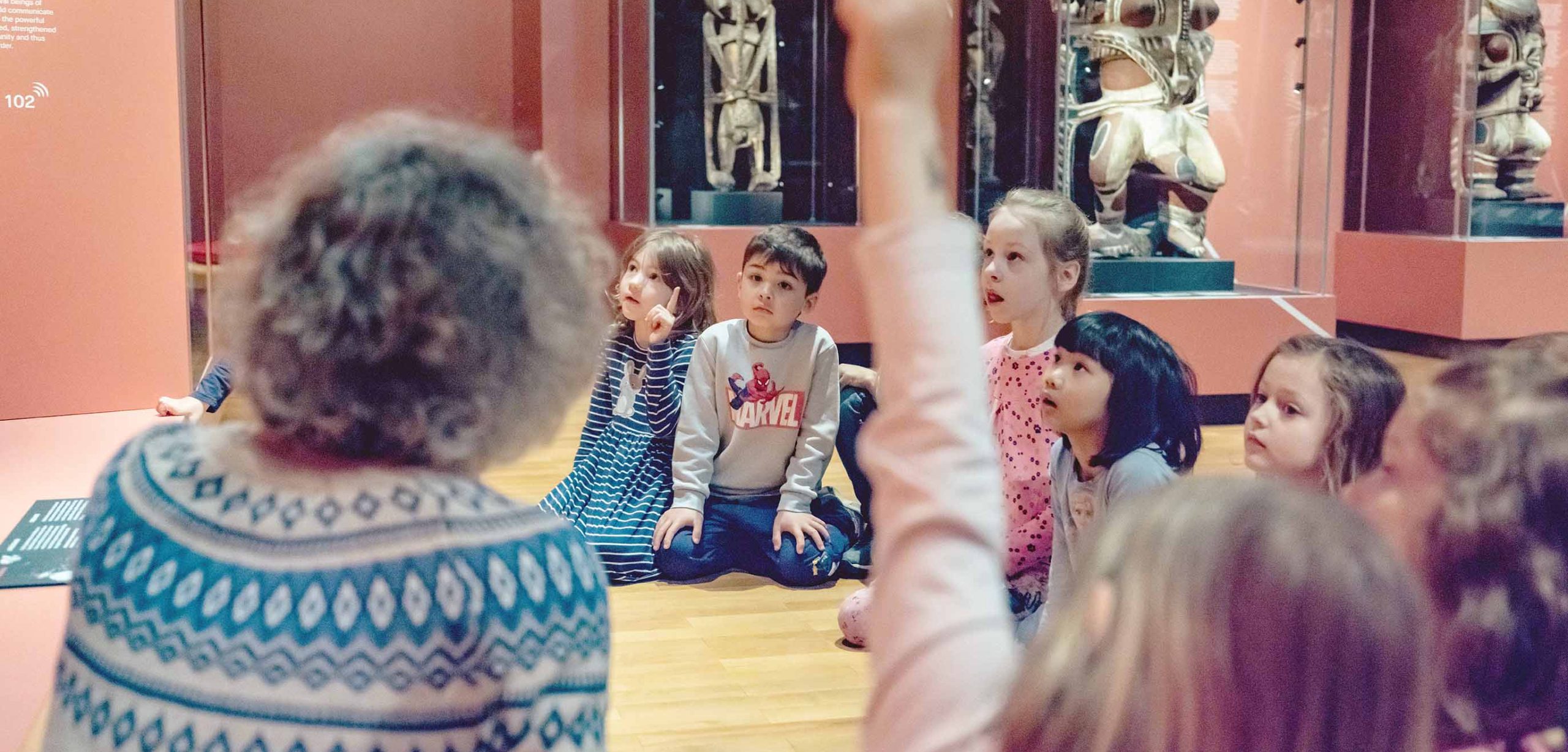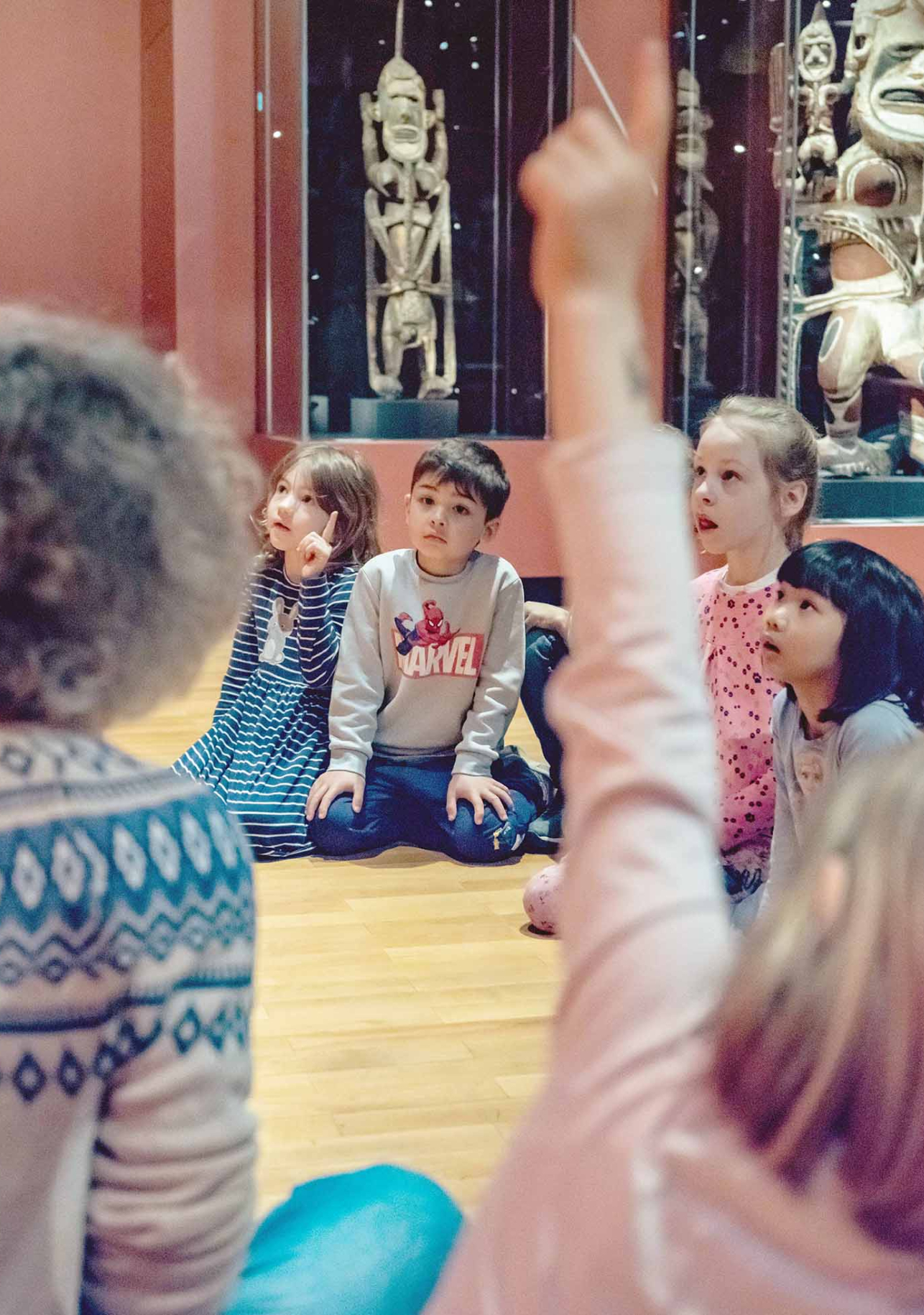Startseite > Program > School at the museum


Dealing with works of art and everyday objects from past and present living environments enables versatile cultural education. The permanent and temporary exhibitions provide space for discussion of social processes, cultural expressions, and aesthetics. Students are exposed to issues that concern them and people around the world: from family, love and work to religion, art and expression, identity, belonging and power. Colonial processes are questioned and skills are promoted that are fundamental for democratic coexistence based on respectful communication and recognition of diverse lifestyles.
We offer tours for all types of schools and grades. The topics are based on the educational plans and cover a variety of subjects, content-related skills and guiding perspectives. Guided tours in different languages are available on request. Guided tours can take place as an overview tour or in one of our suggested formats. Are you missing a topic? We can also design your tour according to your desired theme on request.
Tour duration
One hour as a guided tour only, 1.5 hours as a guided tour with a small activity or 2 hours as a guided tour with a large activity or as a workshop. The activities vary according to the theme and the exhibition.
Group size
Guided tours: up to 25 people
Storytelling tours: up to approx. 12 people
Larger groups can be divided and guided at different times.
Management costs
External schools and kindergartens: EUR 40/hour. plus EUR 1 admission per child or student from grade 9, in permanent exhibitions from 19 years (two accompanying persons free, others reduced)
Stuttgart schools and kindergartens: EUR 1.50 per child or pupil (with BonusCard EUR 0.75) plus EUR 1 admission per child or student from grade 9 in permanent exhibitions from 19 years (two accompanying persons free, others reduced)

Tel. +49.711.2022-579
reachable by telephone:
Tue, Wed, Thu from
9:30 am – 12 pm and
2 pm – 4 pm
(school vacations: Thurs. only)
Please register for the tour by three
Weeks before your desired date.
A visit without a guided tour is also
possible at short notice.
Storytelling Tour: “How are you?” asked Albi, and the Animals Told Their Story
Albi, the alpine swift, nests under the roof of the Linden Museum every summer. Full of curiosity, he flies through the exhibitions one day. He and the children encounter all kinds of animals. They are depicted on paintings, items of clothing or vessels, sculpted from clay or carved from wood. The elephant Seera, the kiwi, the transparent kangaroo Joey or the owl Py – they all talk about their special characteristics or experiences and about living together with humans.
For whom? Recommended for kindergarten from 4 years to grade 1
Exhibition: Spurensuche – Animal adventures in the Linden Museum
Storytelling Tour: Halima and Her Grandmother’s Diary
Halima has found her grandmother’s diary. It is full of mementos of her life in Afghanistan. With Halima, we follow in her grandmother’s footsteps, see works of art, jewelry and clothing. In the bazaar, we are surrounded by countless colors, smells and sounds. In front of the mosque niche, we look at ornamental tiles and listen to the sounds of the muezzin. The journey through the exhibition is varied and dynamic, with scenic storytelling, tactile and movement games.
For whom ? Recommended for kindergarten from 4 years to grade 1
Exhibition: Orient
Storytelling Tour: On the Road with Filemu
In prehistoric times, a crocodile would swim in circles until a whirlpool of water formed. It would then emerge and its body would become the first mainland in the Pacific. The crocodile Filemu takes children on an imaginative journey through figurative imagery, passing sailboats, the dangers of fishing hooks, and the question of who wrapped themselves in feathered cloaks. Myths are told in the meeting house, and a love story finds a happy ending.
For whom? Recommended for kindergarten from 4 years to grade 1.
Exhibition: Oceania
The World Through Children’s Eyes: Living, Learning and Playing Together
What points of contact were and are there between the objects in the collection and the lives of children? Depending on the region and social structures, different things and narratives shaped and continue to shape their growing up. We listen to stories, learn about festivals and games and find out more about works of art and everyday objects. What can we learn from the past for our future?
Teaching field: general studies, art/craft
For whom? Recommended for kindergarten from 4 years to grade 4
Exhibition: topic possible in any permanent exhibition
Dragons, Mythicals and Other Transformers
Fantastic creatures with supernatural abilities can bring good luck, protect you, or cause you sleepless nights. They are the subject of countless stories, fairy tales and poems. Why do they exist? And how are these hybrid beings, heroines or demons represented in pictures, characters or works? We will explore their characteristics and experiences.
Teaching field: general studies, German, ethics
For whom? Recommended for grades 1 to 13
Exhibition: topic possible in any exhibition
Everything in the House from Elephants to Mice?
Pets, farm animals or dangerous predators – it is not always easy for humans and animals to live together. On the one hand, many animals are valued as companions and admired for their special qualities. For example, they are given roles in puppet theater, sail across the sea as figures on boat prows or serve as throne stools. On the other hand, they are also hunted, kept as farm animals for milk and meat production or exploited as work animals. People adorn themselves with their feathers or wear leather clothing. This raises the question of what good and caring coexistence could look like.
Teaching field: general studies, art/craft
For whom? Recommended for grades 2 to 4
Exhibition: Spurensuche – Animal adventures in the Linden Museum
Living Islam – Faith in Everyday Life
The mosque, prayer rug, and compass are just a few of the things used to perform religious duties like prayer, fasting, and pilgrimage. Artistic calligraphy, jewelry, and astronomical instruments provide further evidence of Muslim life and invite visitors to engage in conversations about religion and faith.
Teaching field: general studies, ethics, religious education
For whom? Recommended for grades 3 to 13
Exhibition: Orient
Colors, Ornaments and the Art of Beautiful Lettering
Calligraphy, manuscripts, and books – decorated with geometric and floral patterns, bright blue, or shimmering gold. The boundaries between writing and image are often fluid. By exploring languages, typefaces, and calligraphy exercises, we expand our view of our own language and practice handwriting skills.
Teaching field: German, general studies, art/craft
For whom? Recommended for grades 4 to 13
Exhibition: Orient
With Ink and Brush – Painting and Writing in East Asia
Landscape painting and calligraphy are important art forms in East Asia. They can be found on delicate paper, on silk scroll paintings, or on lacquer boxes. Chinese landscape paintings often depict an idealized nature. Mountains and rivers are considered to be places of power and, like people, are permeated by life energy (qi). We will study the works, learn about the characters, or be inspired to create our own paintings.
Teaching field: German, art/craft
For whom? Recommended for grades 4 to 13
Exhibition: East Asia
Art between Meaning and Use
Carved masks, bronze or stone figures, calligraphy, painting and ceramics are often not just for the eyes, but are used in rituals and imbued with further meanings. In the process, craftsmanship, creative techniques and styles are perpetuated or transformed into something new. This is also true for us, as we can be creative ourselves if we choose.
Teaching field: general studies, art/craft
For whom? Recommended for grades 4 to 13
Topic possible in any exhibition
Dragons, mythicals and other transformers
Fantastic creatures with supernatural abilities can bring good luck, protect you, or cause you sleepless nights. They are the subject of countless stories, fairy tales and poems. Why do they exist? And how are these hybrid beings, heroines or demons represented in pictures, characters or works? We will explore their characteristics and experiences.
Teaching field: German, ethics, literature
For whom? Recommended for grades 5 to 8
Exhibition: topic possible in any exhibition
Living Islam – faith in everyday life
The mosque, prayer rug, and compass are just a few of the things used to perform religious duties like prayer, fasting, and pilgrimage. Artistic calligraphy, jewelry, and astronomical instruments provide further evidence of Muslim life and invite visitors to engage in conversations about religion and faith.
Teaching field: general studies, religious education, ethics
For whom? Recommended for grades 5 to 13
Exhibition: Orient
Colors, ornaments and the art of beautiful lettering
Calligraphy, manuscripts, and books – decorated with geometric and floral patterns, bright blue, or shimmering gold. The boundaries between writing and image are often fluid. By exploring languages, typefaces, and calligraphy exercises, we expand our view of our own language and practice handwriting skills.
Teaching field: German, art/craft
For whom? Recommended for grades 5 to 13
Exhibition: Orient
With Ink and Brush – Painting and Writing in East Asia
Landscape painting and calligraphy are important art forms in East Asia. They can be found on delicate paper, on silk scroll paintings, or on lacquer boxes. Chinese landscape paintings often depict an idealized nature. Mountains and rivers are considered to be places of power and, like people, are permeated by life energy (qi). We will study the works, learn about the characters, or be inspired to create our own paintings.
Teaching field: German, art
For whom? Recommended for grades 5 to 13
Exhibition: East Asia
Art between Meaning and Use
Carved masks, bronze or stone figures, calligraphy, painting and ceramics are often not just for the eyes, but are used in rituals and imbued with further meanings. In the process, craftsmanship, creative techniques and styles are perpetuated or transformed into something new. This is also true for us, as we can be creative ourselves if we choose.
Teaching field: art
For whom? Recommended for grades 5 to 13
Exhibition: topic possible in any exhibition
Natural Materials – Resources and Opportunities
The environment as a habitat for humans, animals and plants has many faces: sandy desert, tropical rainforest or stormy coast. Food, clothing, jewelry or even shelter – many things used to be more directly connected to the natural environment than people experience in many places today. What can we learn from historic objects about sustainable use of natural materials?
Teaching field: Geography, everyday culture, nutrition, social issues (AES)
For whom? Recommended for grades 5 to 13
Exhibition: Oceania, Orient, East Asia, Wo ist Afrika?, America Room
From the First Moment to Saying Goodbye
Many biographical events are celebrated, commemorated, or honored with rituals: from naming, to growing up, to marriage, to remembering the dead. How are these events accompanied, and what objects play a role? Depending on the society, certain narratives, ideas, or religious practices are also associated with these events.
Teaching field: ethics, religious education
For whom? Recommended for grades 5 to 13
Exhibition: topic possible in any exhibition
Hinduism in India
Hindu deities remind us of the creation and passing of life. They shape the daily lives of devotees in magnificent festivals and temples, in meditation and recitation of sacred scriptures. We look at temple figures in bronze or stone, decipher scenes on reliefs, and listen to stories about Ganesha, Siva, or Parvati. Along the way, we engage in conversation about religious beliefs and practices.
Teaching field: ethics, religious education
For whom? Recommended for grades 5 to 13
Exhibition: South and South East Asia
Buddhism in South and Southeast Asia
Over the centuries, the teachings of the Buddha have evolved into various Buddhist traditions. Sculptures, paintings, a sand mandala, and other works from India, Tibet, and Myanmar offer insights into the forms, worldviews, and practices of Buddhism in the past and present.
Teaching field: ethics, religious education
For whom? Recommended for grades 5 to 13
Exhibition: South and South East Asia
Buddhism in China and Japan
Originating in northern India, Buddha’s teachings spread to China and Japan. The Zen Buddhist way of thinking is expressed in calligraphy, the tea ceremony, and meditation. Moments of silence and meditation are part of many religions. What ideas are associated with the teachings of Zen Buddhism?
Teaching field: ethics, religious education
For whom? Recommended for grades 5 to 13
Exhibition: East Asia
Colonialism – Economic Interests, Racism and Collective Rage
Why were objects collected for museums during the colonial period? What were the social, economic, and political effects of the colonial division of Africa? Imperialist strivings for power not only shaped the 19th century, but continue to do so today. At the political level, restitution processes are underway, and provenance research is attempting to learn more about the origins of objects based on historical documents. How do we deal with this difficult heritage?
Teaching field: history, social studies
For whom? Recommended for grades 6 to 13
Exhibition: Wo ist Afrika?
Just in Your Head? Workshop on Diversity and the Emergence of Wtereotypes
Where do these ideas come from that make some things seem familiar and others strange? Starting with objects from the collection that have complex stories and meanings, we approach the big question with simple exercises: What happens when people, things, or ways of life are viewed from only one perspective? Together, we will uncover and discuss patterns of thinking and develop strategies to combat prejudice, exclusion, and racism.
Teaching field: social studies, social issues (AES), ethics, school without racism
For whom? Recommended for grades 7 to 13
Duration: 2 hours
Exhibition: Wo ist Afrika?
In cooperation with: AfroKids International e. V.
Migration, Globalization and Cultural Exchange
Living together in a globalized world is characterized by migratory movements. People travel, fall in love, work abroad, move or have to flee. This is always accompanied by an exchange of ideas, things and techniques. These processes, which shape our understanding of society, aesthetics, or religion, can also be seen in many objects. For example, mutual influences can be traced through stylistic features, colors, or craft techniques.
Teaching field: social studies, ethics
For whom? Recommended for grades 7 to 13
Exhibition: topic possible in any exhibition
On the Move: Postcolonial Perspectives on Flight and Migration
How did German colonial rule influence the economy, politics and land distribution in the colonial territories? To what extent do the consequences of colonial rule affect current refugee and migration movements? Based on the permanent exhibition “Where is Africa?”, we will examine these questions together with BtE speaker Rebekka Schön and discuss the connection with our everyday lives.
Teaching field: social studies, ethics, history
For whom? Recommended for grades 8 to 13
Duration: 2.5 hours
Exhibition: Where is Africa?
In cooperation with: Bildung trifft Entwicklung (BtE)
A variety of life worlds are addressed through the use of art and everyday objects. Exchanging ideas and trying out different games together creates new encounters in the group and strengthens the sense of community. Creative activities such as drawing, printing or calligraphy exercises encourage creative skills.
Tours can be adapted according to language level and age group.
Tour topics can be found under Primary or Secondary.
Or choose from the following topics in the exhibition Islamic Orient.
Learning Through Play as a Team
Working in small groups, students independently explore four areas of the Orient exhibition. To overcome language barriers, the focus is on observation, vocabulary learning, drawing, a game of skill, and a role-playing game.
For whom? Recommended for multilingual preparatory and VABO classes
Exhibition: Orient
The curricula for social studies, religion, ethics, art, history, science, geography, and English have many connections to anthropological topics. Seeing the originals in the museum can complement, illustrate, and deepen classroom lessons. In addition, a visit to the museum contributes to “Education for Tolerance and Acceptance of Diversity” (BTV).
We offer public professional training sessions on both temporary and permanent exhibitions. The content of the exhibition, possible classroom connections, suggestions for project days or ideas for everyday life with groups of children are presented. You can also book private training sessions just for your staff in schools, day care centers, or for a study seminar. Contents, dates and duration, whether a two-hour program or an educational day, can be arranged individually.
Dienstag bis Samstag, 10 – 17 Uhr
Sonn- und Feiertage, 10 – 18 Uhr